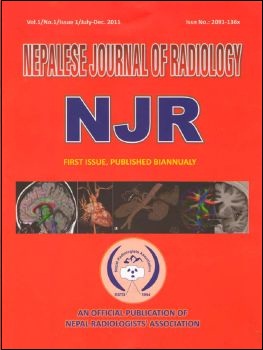Typical MRI Features in Spontaneous Intracranial Hypotension: A Rare Cause of Headache
DOI:
https://doi.org/10.3126/njr.v1i1.6324Keywords:
MRI, SIH, Lumbar Puncture, CSFAbstract
Spontaneous CSF leakage from the spinal canal can give rise to spontaneous intracranial hypotension (SIH). Typically, these patients complain of orthostatic (postural) headache, have very low CSF pressure on lumbar puncture (LP) and usually respond to conservative treatment or by an epidural blood patch. The characteristic MRI features include subdural fluid collections, enhancement of the pachymeninges, engorgement of venous structures, pituitary hyperaemia and sagging of the cerebellar tonsils. Radiologists should recognize the typical clinical and imaging features of SIH and distinguish it from more sinister or malignant differential diagnosis, in order to prevent a delay in diagnosis or unnecessary surgical intervention, especially in resource-constrained situations in developing nations.
DOI: http://dx.doi.org/10.3126/njr.v1i1.6324
Nepalese Journal of Radiology Vol.1(1): 45-51
Downloads
Downloads
Published
How to Cite
Issue
Section
License
This license enables reusers to distribute, remix, adapt, and build upon the material in any medium or format, so long as attribution is given to the creator. The license allows for commercial use.




